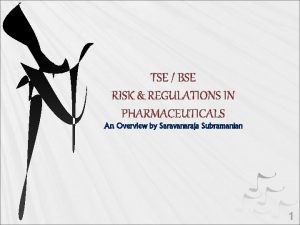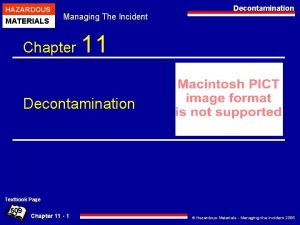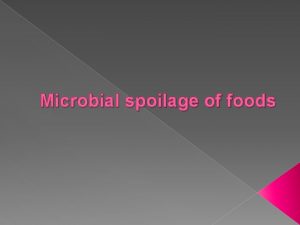Food spoilage and contamination The principals of food


- Slides: 2

Food spoilage and contamination. The principals of food safety. Key words: Catalyst: a substance that speeds up a chemical reaction Contaminate: making food unsafe to eat by allowing it to come into contact with micro-organisms that will grow and multiply Enzymes: Natural substances in living things that speed up chemical reactions. Food poisoning: an illness caused by eating food contaminated with micro-organisms Food spoilage: food made unfit + unsafe to eat High risk food Perishable): Foods containing protein, moisture, requiring refrigeration. These easily support the growth of microorganisms e. g. pathogenic bacteria. E. g. meat, fish, milk, cream, eggs) Micro-organisms: tiny forms of life only visible with a microscope Micro-organisms are found in many places. They spoil food as they make it unsafe to eat because it is contaminated with their waste products; the toxins (poisons) they produce and their physical presence. 3 groups spoil food and cause food poisoning: yeasts, moulds, bacteria. To grow and multiply they need: • The right temperature: 37⁰C is ideal. At 0 – 5⁰C they multiply and grow BUT slowly. If too hot they will be destroyed. • Food. Nutrients are needed for growth. • Moisture i. e. water is needed for all biological processes. If t there is no water/moisture they cannot grow/multiply. If a water is removed e. g. drying; adding high concentrations of sugar or salt (where the water from the cells is removed by osmosis). • Time. Bacteria multiply every 10 – 20 minutes (in the right conditions) by binary fission. • The right amount of acidity/alkalinity (p. H). If too acidic or alkaline micro- organisms cannot grow. Preserving food in vinegar is a method of preventing micro-organisms from multiplying. • Micro-organisms (especially bacteria) grow easily in high risk (or perishable foods). These will spoil quickly and are most likely to cause food poisoning because bacteria and other micro-organisms can grow and multiply very easily and quickly in them. • They have the right conditions for their growth: nutrients (especially protein) and water/moisture. • These types of foods spoil very quickly and must be refrigerated, cooked thoroughly and eaten within a few days. Enzymes are natural substances (mostly proteins) which are found in foods and all living things. • They are called biological catalysts • Enzymes cause fruits and vegetables that have been harvested to ripen and eventually break down the cells and tissues in them. They change colour and any starch they contain is broken down and converted to sugar so they soften and sweeten. GCSE Food Preparation & Nutrition West Somerset College Signs of food spoilage include: • mould growing on the food • bruising of fruit • change in the colour of the food • loss of water/shrinkage • sprouting in potatoes • change in texture e. g. slime, hardening, graininess and development of an unpleasant taste • food curdling • milk that has separated. There a number of ways in which food can spoil. Ripening caused by enzymes: Enzymes cause foods such as fruits to ripen. Fruit ripens because the enzymes in the fruits have caused chemical reactions changing the texture, flavour and aroma of the fruits. The sugar content increases. Browning caused by enzymic action: Plant cells contain storage vacuoles (spaces) in the centre, which contain a variety of natural substances. Around the outside of the vacuole is cytoplasm which contains substances called enzymes. When broken open, the enzymes in the cytoplasm and O 2 from the air mix with the substances in the vacuole = oxidation which results in colour change e. g. brown apples; black bananas. Mould growth on foods: Moulds are a type of micro-organism which contaminate food by growing and multiplying on it (if the conditions are right). Moulds send out tiny spores that land on food and germinate. The germinated spores send down roots into the food (the roots are called mycelium), which will send up thousands of shoots with a fruiting body on each. These are small, blue-green lumps in a softened area with a white appearance like lace. Yeasts: Spoil foods that contain sugar e. g. fresh and dried fruits (e. g. grapes, apples, strawberries). They settle on food grow, then ferment the sugar to produce CO 2 gas and alcohol. This shows as pale brown, spots on the skin of the fruit, which becomes brown and mushy as the yeast continues to grow.

Micro-organisms used in food production. Key words: Homogenisation: Prevents the fat in the milk separating out forming a layer of cream on the surface. The fat droplets are forced through fine sieves to break them up. Pasteurisation: Heating raw milk to 72⁰C for 15 seconds to kill pathogenic microorganisms. Pathogenic: Harmful microorganisms, e. g. bacteria/moulds causing food poisoning. Non-pathogenic: microorganisms that do not cause food poisoning. GCSE Food Preparation & Nutrition West Somerset College Micro-organisms used in cheese production 1. Milk is pasteurised. Because it is a perfect food for bacteria to grow in. Pasteurisation destroys the pathogenic bacteria. 2. Bacteria culture is added. This turns the milk sugar (lactose) into lactic acid. This coagulates milk protein; adds flavour, texture and acts as a preservative. 3. An enzyme (rennet) is added. This clots (coagulates) the milk proteins. = curds and whey. 4. The curds are cut to release the watery whey 5. The whey is collected and drained. It is used to manufacture baked products as ‘whey protein’ 5. The curd is pile d up to release more whey. 6. The curd is heated and cut to develop texture. 7. The cheese is than salted (as a preservative and flavouring) and pressed. It is then ripened. This matures the cheese. The longer it is ripened, the stronger and more mature the cheese. In blue veined cheese e. g. Stilton the spores of special moulds are added at stage 2. These germinate (stage 7) as the cheese ripens which adds blue veins and a particular flavour. Micro-organisms used in bread production A special non pathogenic baker’s yeast is used. Given the right conditions of warmth, moisture, food (sugar or starch) + time, it breaks down the starch in the flour, adds flavour and produces CO 2 gas bubbles, which make the dough rise. (Fermentation). It also produces alcohol, which adds flavour and escapes in the oven. There are 3 types of yeast: fresh, dried and fast acting. Fast acting contains ascorbic acid which speeds up the process of bread making. Micro-organisms used in yogurt production • Yogurt is made from milk that has been heat treated (to destroy pathogenic bacteria). Whole, semi and skimmed are used. • The milk is homogenised to give a smoother texture. It is then pasteurised 85⁰C to 95⁰C to destroy micro-organisms. • It is cooled to 42⁰C = the right temperature for bacteria to grow and ferment the lactose in the milk. (Two types of non-pathogenic bacteria are used as a culture). • The mixture is incubated (held at a temperature of 37⁰C to 44⁰C) for 4 – 6 hours. • The bacteria ferment the lactose sugar in the milk and produce lactic acid. (The lactic acid denatures and coagulates the milk proteins, which makes the milk become semi-solid in texture). 0. 8 to 1. 8% of the bacteria become inactive but are still alive. • The p. H is measured = 4. 5⁰C. • The lactic acid and other natural substances that are produced give the yogurt its distinct, traditional flavour. • The milk is cooled to 4. 5⁰C to stop the bacteria growing = natural ‘live’ yogurt. This is not pasteurised. • Other yogurts are then pasteurised to kill any bacteria. • Fruit and/or other flavours are added. • It is then packed, sealed and transported to the consumer.



